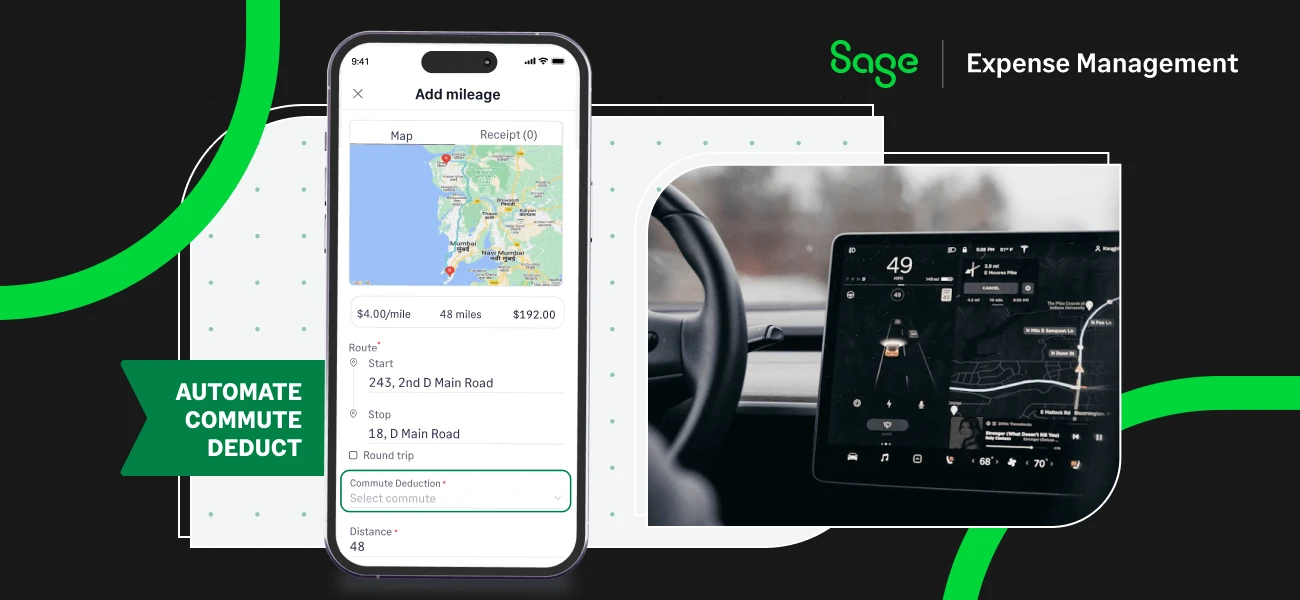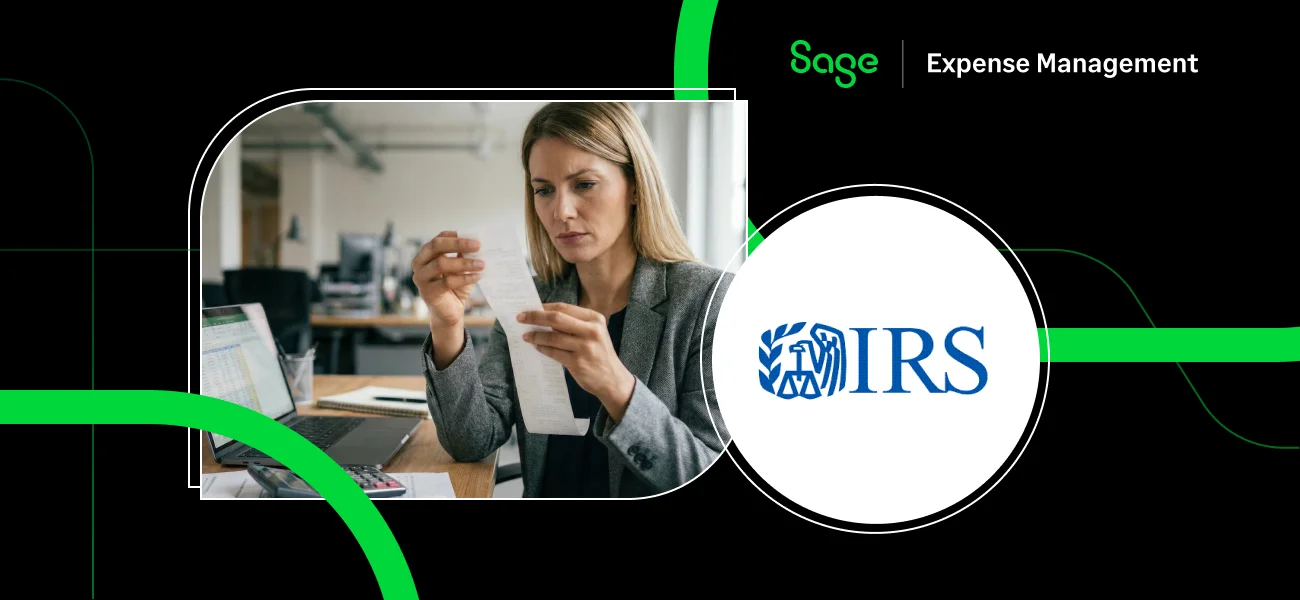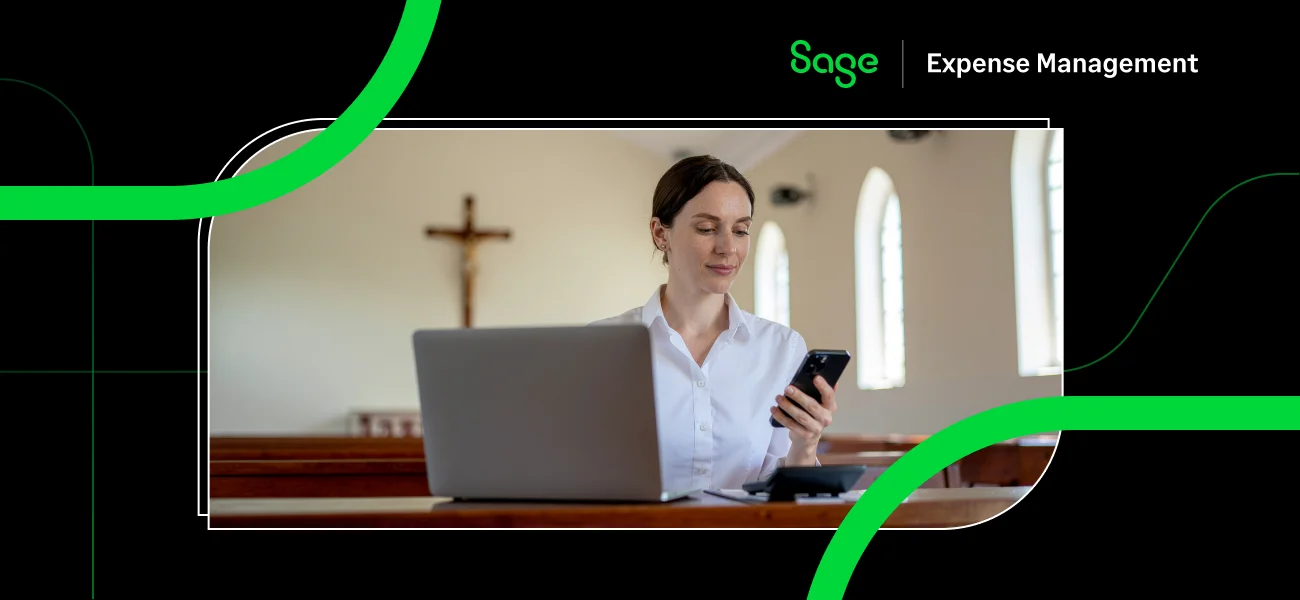Did you know that the miles driven for business purposes can be deducted from your tax returns as a business expense?
That’s right–when you’re driving those long distances to meet a client or take a prospect out for lunch, you’re actually doing things that can lower your tax liability. The only thing you need to remember is that not everything qualifies as business mileage.
Here’s a detailed overview of what the IRS accepts as business mileage and the difference between business mileage and commuting mileage.
The Different Types of Mileage
Now the IRS recognizes three different kinds of mileage:
- Personal: when it’s not driven for any business purpose (going shopping or taking your family for a movie)
- Business: when it’s related to business purposes (attending a conference, visiting a client)
- Commute: driving from your place of residence to your workplace
Let’s take a deeper look at business and commuting miles.
What Are Business Miles?
The IRS defines business miles as the mileage driven between two places of work. Anytime you drive from one workplace to another, it’s a business mile.
What Qualifies As Business Mileage For The IRS?

- Driving to meet a client at their office or another work location
- Running business errands during your workday, like picking up office supplies or making deliveries
- Traveling to different work locations throughout the day
- Traveling between your main job and a temporary work location
- Getting from your home to a temporary workplace if your regular job is at another location
Key-takeaway: Business miles are tax-deductible under certain conditions, helping you lower your tax bill.
What Are Commuting Miles?
Commuting miles are the miles driven between your home and regular workplace. This also includes:
- Your daily drive to and from work, even if you work in a different location occasionally
- Traveling to a satellite office, if it’s your regular location, even if it’s different from your main office.
Are Commuting Miles Tax Deductible?
Commuting miles are generally not tax-deductible.
But If I Have A Home Office, How Would Commuting Miles Work Then?
If your home office qualifies as your principal place of business (according to IRS Publication 587), then you can deduct travel costs between your home office and other work locations within the same field.
Example 1
You have a regular office in your city, but your employer sends you to training at a different location for a week. You drive directly from your home to the training site every day. You can deduct the daily round-trip cost between your home and training location.
Example 2
Your primary workplace is your home office. In this case, you can deduct the round-trip cost between your qualified home office and your client’s or customer’s location.
Example 3
You don't have a regular office or a qualifying home office. Commuting between your home and your first client/customer within your city is considered a nondeductible commuting expense. The same applies to the travel between your last client and your home. However, travel costs between different client locations are deductible.
In simple terms, if your home office is your main work base, you can deduct travel from there to other work locations. But regular commutes between home and any work location (including your usual office or first client) are not deductible.
Business Miles vs Commuting Miles: The Differences

Let’s understand the main differences between business and commuting miles with an example:
John is a salesperson who works from a dedicated home office that meets the IRS requirements for the principal place of business:
Business Miles
- John drives 10 miles to meet a client at their office. (Deductible)
- John drives 5 miles from his home office to a local store to pick up supplies for his business. (Deductible)
Commuting Miles
- John drives 15 miles from home to his dedicated home office. (Not deductible)
How Can You Deduct Business Mileage?
You can use two ways to deduct business mileage once you’ve figured out your business miles–the standard mileage rate or the actual expenses method.
The Standard Mileage Rate
Each year, the IRS establishes a standard mileage rate that allows you to write off costs for every business mile driven. As of January 1, 2026, the adjusted standard mileage rates for operating an automobile—including vans, pickup trucks, and panel trucks—are as follows:
- Business miles: The standard rate is 72.5 cents per mile, which is an increase of 2.5 cents from the 2025 rate.
- Medical or moving miles: This rate is 20.5 cents per mile. For moving purposes, this deduction is specifically available to members of the Armed Forces on active duty and certain members of the intelligence community.
- Charitable miles: The rate for miles driven while rendering services to a charitable organization remains 14 cents per mile.
These rates apply to all types of automobiles. If you are using the business standard rate, please note that the portion treated as depreciation for 2026 is 35 cents per mile.
For more information, please refer IRS issues standard mileage rates for 2026.
To qualify for the standard mileage rate, your car usage must meet the following criteria:
- Ownership or Lease: You must own or lease the car you're using.
- Fleet Size: You cannot operate five or more cars simultaneously (like a fleet).
- Depreciation Deductions: You can't have claimed depreciation using methods other than "straight-line" on this car in the past.
- Section 179 Deduction: You cannot have taken advantage of the Section 179 deduction for this specific car.
- Special Depreciation Allowance: This car isn't eligible for the special depreciation allowance.
- Leased Car and Actual Expenses: If your car is leased, you cannot claim actual expenses for it after 1997.
Additionally:
- Choosing the Rate: When claiming the standard mileage rate for your owned car, you must choose to use it in the first year the car is used for business. After that, you can switch between this method and claiming actual expenses in subsequent years.
- Leased Car Consistency: If you choose the standard mileage rate for a leased car, you must stick with it for the entire lease period (including renewals).
For more information, please refer to IRS Topic no. 510, Business Use of Car.
The Actual Expenses Method
The actual expense method allows you to deduct the true cost of operating your car for business purposes. This involves calculating the portion of various expenses that are attributable to business miles.
Here’s a breakdown of what you can include:
- Fuel costs: Gas, oil, etc.
- Maintenance: Repairs, tires, etc.
- Vehicle registration and licensing fees.
- Insurance costs.
- Depreciation (for owned vehicles) or lease payments (for leased vehicles).
However, only the portion of these costs corresponding to the percentage of miles driven for business is deductible.
To learn more about these methods, check out our quick Guide to tracking mileage for taxes.
Other Car Write-Offs You Can Take On Top Of Business Mileage
- Parking and tolls: these are deductible if incurred for business purposes
- Interest on car loans: if the loan is used for a business vehicle, the interest might be partially deductible.
- Section 179 deduction: This allows immediate deduction of a portion of the car's cost in the year it's placed in service, but specific limitations and qualifications apply.
Remember: Record-keeping is crucial as the law requires that you substantiate your expenses with adequate records to support your claim.
Tracking Your Business and Commuting Miles with Sage Expense Management (formerly Fyle)
Simplify tracking business and commuting miles for your employees with Sage Expense Management's intuitive app.

Powered by Google Maps, simply enter start, stop, and any additional locations, and Sage Expense Management automatically calculates the distance and cost based on your custom mileage rates.
It also lets admins and employees easily deduct commute miles from a mileage expense form without having to manually handle the deductions.
Admins can enable the commute deduction feature for the entire organization.
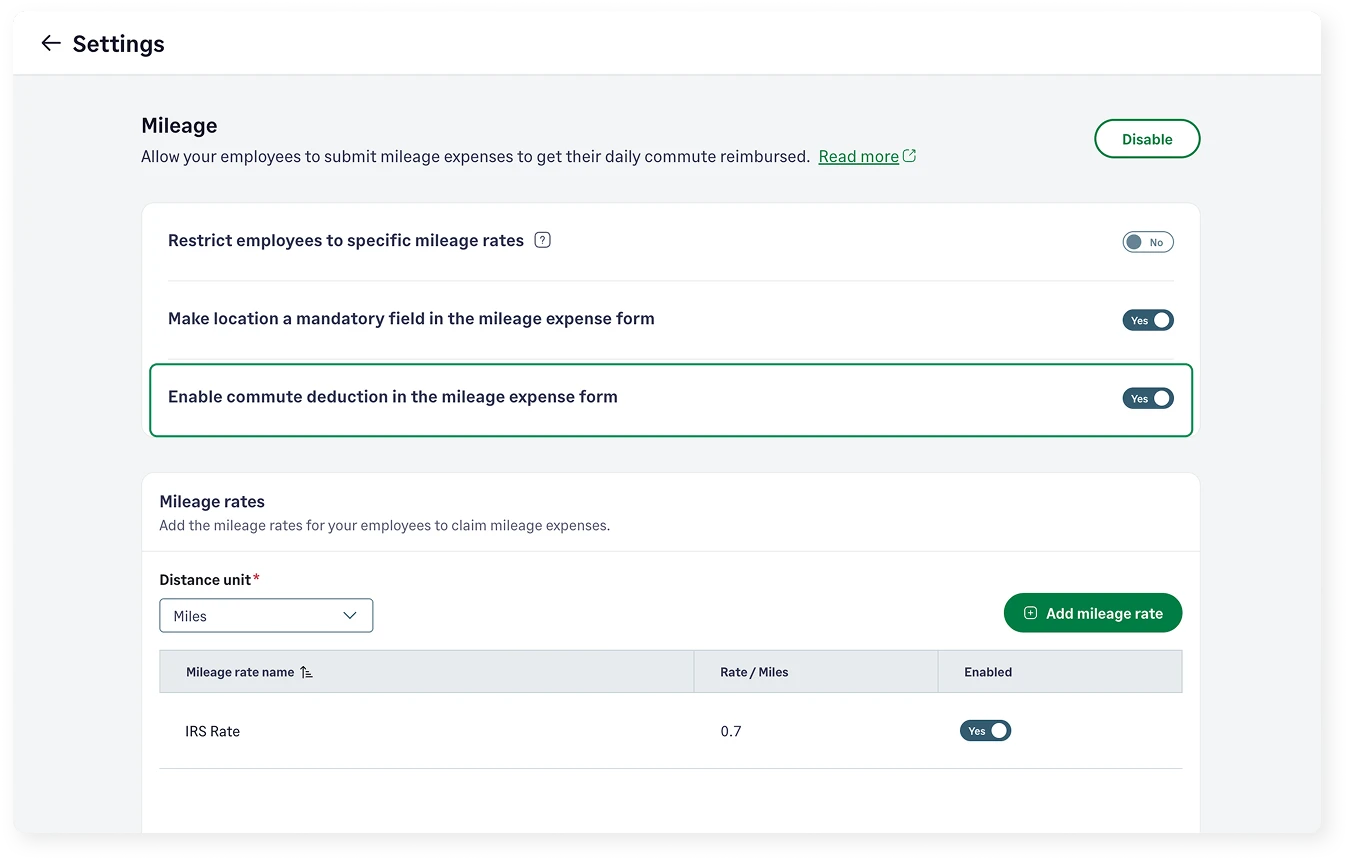
This triggers a two-step process for employees:
- First, they set their home and office locations in their personal settings.
- Then, when filling out a mileage form, they'll see an option to deduct the commute distance, either one-way or round-trip.
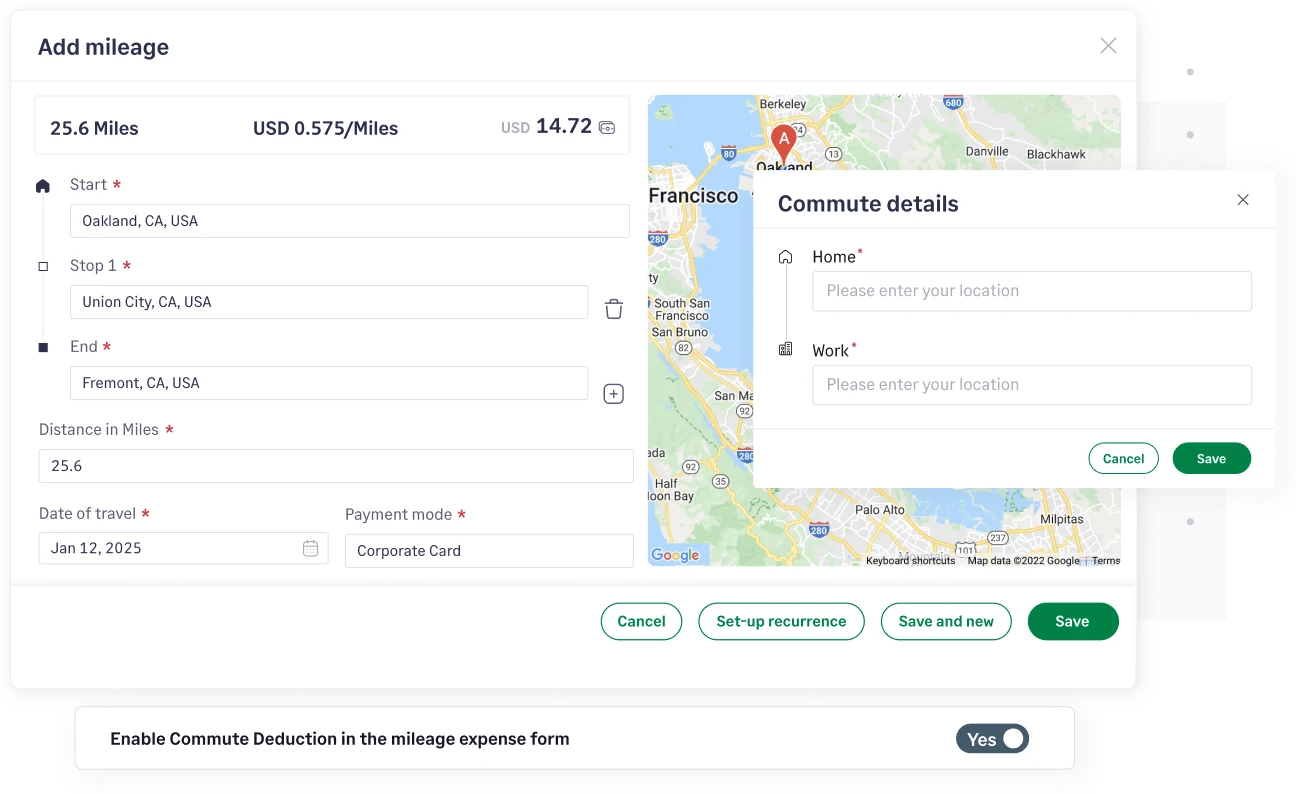
Regardless of their selection, Sage Expense Management automatically calculates and removes the chosen commute distance from the original business trip distance, simplifying expense reporting.
Additionally, admins retain complete visibility into whether the commute deduction has been applied, including both the actual and claimed distances for each trip.
Curious to see our automated commute deduction in action? Here’s a two-minute video showing you how.
But that’s not all, here’s everything else you can do with Sage Expense Management's mileage and expense tracker app.
- Automate mileage tracking: Eliminate the use of spreadsheets to track unverified miles.
- Reduce repetitive entries: Duplicate or automate recurring mileage submissions for frequently used routes (e.g., home to office).
- Multi-stop tracking made easy: Add stops to your mileage report with Sage Expense Management automatically calculating the total distance and cost for each leg of your journey.
- Timely Reimbursements: Streamline mileage reimbursements and ensure employees receive timely payments using Sage Expense Management's ACH system. You can pay multiple employees with a single click.
Expand beyond mileage tracking
- Text-based receipt submission: Sage Expense Management integrates with Visa and Mastercard to give you real-time credit card spend notifications via text message. Reply with a photo of your receipt, and Sage Expense Management will automatically match it to the corresponding expense.
- Seamless receipt tracking: Submit business expense receipts directly from commonly used apps like Gmail, Outlook, Slack, Teams, and more.
- Streamlined accounting: Sage Expense Management integrates with popular accounting software like QuickBooks, NetSuite, Sage Intacct, and Xero, automating pre-accounting processes.
{{mileage="/cta-banners"}}



.webp)
